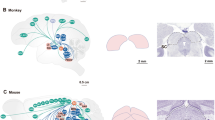Summary
Responses of superficial-layer, texturesensitive complex cells in cat striate cortex to relative motion between an oriented bar stimulus and its textured background were recorded. Some cells responded best to motion in one particular direction across the receptive field of the cell, irrespective of whether the bar and background moved simultaneously in the same (in-phase) or opposite (antiphase) directions. Others showed a clear preference for either in-phase or antiphase relative motion, irrespective of direction of motion across the receptive field.
Similar content being viewed by others
References
Frost BJ (1978) Moving background patterns alter directionally specific responses of pigeon tectal neurones. Brain Res 151: 599–603
Frost BJ, Scilley PL, Wong SCP (1981) Moving background patterns reveal double-opponency of directionally specific pigeon tectal neurons. Exp. Brain Res 43: 173–175
Frost BJ, von Grunau MW (1981) Double opponency of direction specific units in cat's lateral suprasylvian visual area. Invest Ophthal Vis Sci [Suppl] 20: 149
Hammond P (1978) Directional tuning of complex cells in area 17 of the feline visual cortex. J Physiol (Lond) 285: 479–491
Hammond P (1979) Stimulus-dependence of ocular dominance and directional tuning of complex cells in area 17 of the feline visual cortex. Exp Brain Res 35: 583–589
Hammond P (1980) A semi-chronic preparation for cortical recording. J Physiol (Lond) 298: 3–4P
Hammond P, MacKay DM (1975) Differential responses of cat visual cortical cells to textured stimuli. Exp Brain Res 22: 427–430
Hammond P, MacKay DM (1977) Differential responsiveness of simple and compex cells in cat striate cortex to visual texture. Exp Brain Res 30: 275–296
Hammond P, MacKay DM (1981) Modulatory influences of moving textured backgrounds on responsiveness of simple cells in feline striate cortex. J Physiol (Lond) 319: 431–442
Hammond P, Reck J (1980) Influence of velocity on directional tuning of complex cells in cat striate cortex for texture motion. Neurosci Lett 19: 309–314
Mandl G (1974) The influence of visual pattern combinations on responses of movement sensitive cells in the cat's superior colliculus. Brain Res 75: 215–240
Movshon JA (1975) The velocity tuning of single units in cat striate cortex. J. Physiol (Lond) 249: 445–468
Rizzolatti G, Camarda R (1977) Influence of the presentation of remote visual stimuli on visual responses in cat area 17 and lateral suprasylvian area. Exp Brain Res 29: 107–122
Wagner H-J, Hoffmann K-P, Zwerger H (1981) Layer-specific labelling of cat visual cortex after stimulation with visual noise: a [3H] 2-deoxy-D-glucose study. Brain Res 224: 31–43
Author information
Authors and Affiliations
Additional information
Supported by the Medical Research Council (grant no. G 80/ 0833/4/N to P. Hammond)
On leave from: Newcastle-upon-Tyne Polytechnic
Rights and permissions
About this article
Cite this article
Hammond, P., Smith, A.T. On the sensitivity of complex cells in feline striate cortex to relative motion. Exp Brain Res 47, 457–460 (1982). https://doi.org/10.1007/BF00239363
Received:
Accepted:
Issue Date:
DOI: https://doi.org/10.1007/BF00239363




